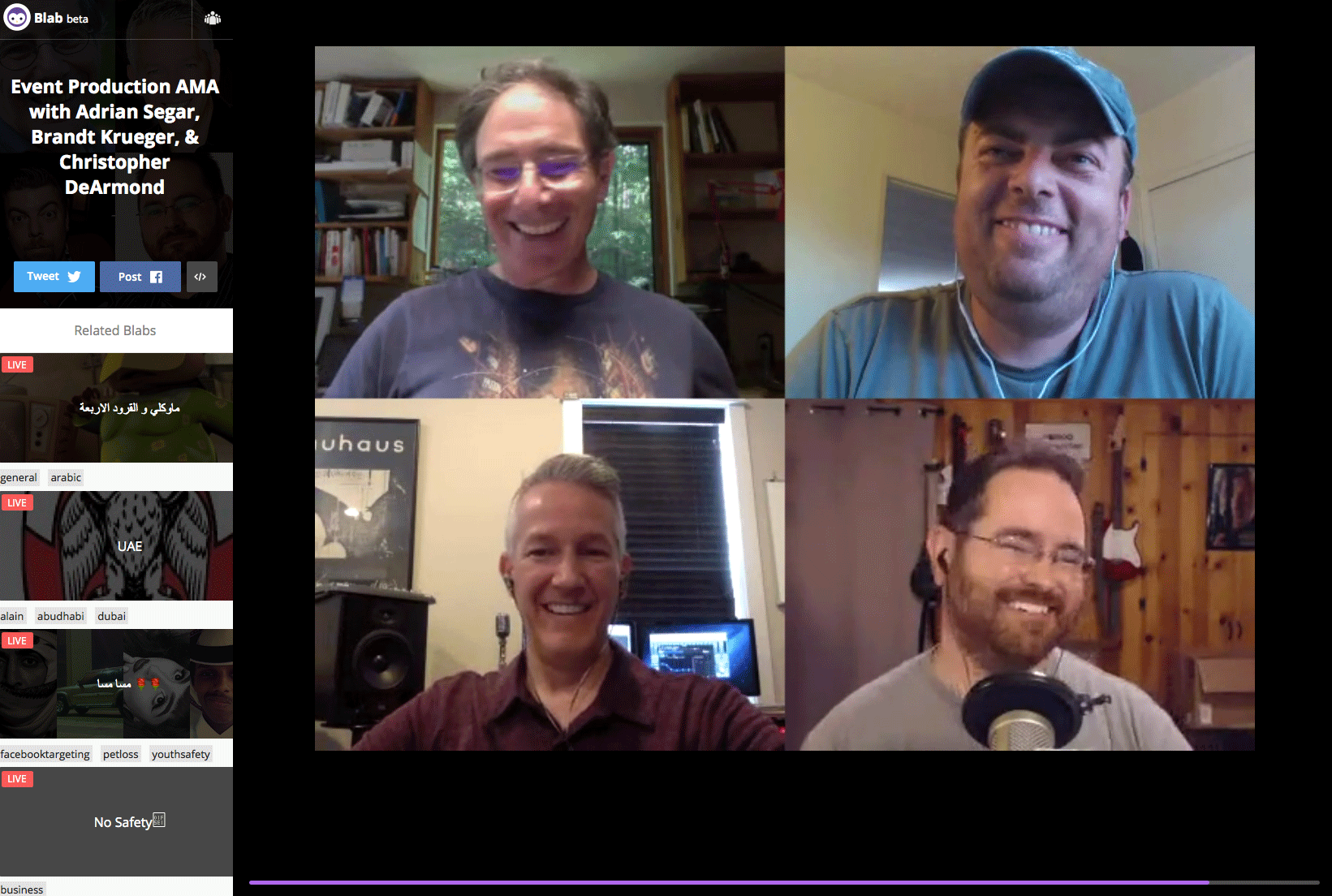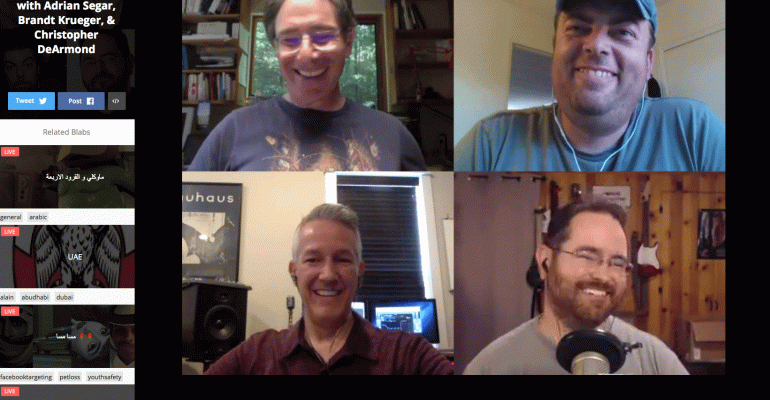 I participated in my first Blab—kind of like a Periscope-type video chat for groups—and got a heaping pile of great thoughts about AV and production issues during the June 30 #Eventprofs Happy Hour, "Ask Me Anything About Event Production.” Adrian Segar, participant-led-conferences advocate, author, and facilitator extraordinaire, led the discussion, which featured Brandt Krueger (owner, Event Technology Consulting) and Christopher DeArmond (managing director, Freedom Event Services). Toward the end of the two-hour chat, professional conference moderator Glenn Thayer also hopped up on screen to add his perspective.
I participated in my first Blab—kind of like a Periscope-type video chat for groups—and got a heaping pile of great thoughts about AV and production issues during the June 30 #Eventprofs Happy Hour, "Ask Me Anything About Event Production.” Adrian Segar, participant-led-conferences advocate, author, and facilitator extraordinaire, led the discussion, which featured Brandt Krueger (owner, Event Technology Consulting) and Christopher DeArmond (managing director, Freedom Event Services). Toward the end of the two-hour chat, professional conference moderator Glenn Thayer also hopped up on screen to add his perspective.
The entire discussion, including the live chat archive, is available here, but here’s a short-form version of some of the top tech we talked about.
Brandt, who fielded the Blab questions solo until Chris finished wrapping up with a client, said some of the things he’s seeing start to take off include:
1. Projection mapping/video walls. This is “one of those things that if you put some creativity into it, you can blow people away with what is not a terribly expensive piece fo gear,” Brandt said.
Chris, whose company offers video walls—added that, with LED tile walls, you can just replace the tile when one goes out. With traditional projection, when a projector goes down, you have to get a whole new projector, or replace the whole screen if you get a rip.
This technology is getting cheaper and cheaper, they said, and more LED walls are hitting the market now that the costs are coming down. So the differentiator now isn’t just the cost, but more the service that goes with the equipment. “It’s pushing us all to improve what we do,” Chris said.
2. Drones, but not for aerial photography. Brandt said there are a lot of beautiful things being done with drones in Europe where they use them to create floating artistic pieces. He said Disney also wants to do some interesting things with drones, like using computer-controlled drones to manipulate 100-foot-tall marionettes. Drones are also being used as individual pixels that come together to form a picture, then blown apart. I have not seen this, but it sounds pretty amazing.
3. Virtual reality is also something Brandt said he’s warming up to as something that can be used for groups. At Eventex in Sofia, Bulgaria, this year, he saw an example of a phenomenal use of VR for Lexus Audi, the car. It showed everyone sitting in comfy chairs like in a theater, puting on VR goggles, and having a virtual experience together. “People were grabbing each other’s hands as they swooped around the cars,” he said. When they took off the goggles, the car was there so they could look at it in reality. “That playfulness of using VR and real life events is where I see VR working for events.”
What about site inspections via VR? Is it good enough to make a decision? Not yet, Brandt said, but it’s good enough to help narrow it down. Even Google Cardboard, a low-cost VR viewer for smartphones, has a lot of potential for promotional materials. One venue at a trade show he went to was handing out a Google Cardboard with a 360-degree tour along with the standard glossy brochure.
And 360-degree cameras are coming down in price enough to be practical sales and marketing tools, even though they can’t be used in real time the same way you could do a tour with VR. But they could also be personalized, with a sales person walking a specific planner around the space.
4. Augmented reality also has a lot of potential, Brandt said. Once you get on site, you could use AR to see the space overlaid with different room sets. This could come in handy when the boss thinks you could set the room for more people than it can comfortably hold—you’d be able to show them how little space there would be between chairs.
There also now is a commercial Google Tango version that has all the sensors you need for room mapping. “So you can walk into a room and wave your smartphone around and get every measurement and a 360-degree view you can pop into a headset,” Brandt said.
The augmented reality and spacemapping that’s coming from Google’s Project Tango is going to be great for technical directors and others on the AV side, Brandt said. If you can send just one fewer person to do a site visit and have them do the VR tour instead, we’re saving time and money—and reducing our carbon footprint.
5. 3-D Holographic speakers. Adrian brought up the concept, which Brandt said he’s only seen in video but hears it’s very compelling. Because it’s a form of projection technology, it’s also coming down in price very quickly, so we may be seeing more of it. I would love to see that in person!
6. LED wall projection is also becoming much more common as the resolution of the screens continues to improve. People are using them more as stage décor that can continually change as you shift the colors, images, and other content on the screens.
7. Audience participation tools. Since meetings are all about communication, sound is always key, said Brandt, and now that audience participation is on the rise, so is the need to find ways to get people heard. Two of the tools they talked about are Catchboxes (throwable padded mics) and Crowd Mics, which turn people’s cellphones into mics via a microphone app.
We also got into some pie-in-the-sky tech that may be coming someday soon
• Wearable tech that will replace the need for apps. There are more than a few people predicting the demise of the app within 10 years, Brandt said. For group polling, someday everyone will just have a magic ring they can hold up. Adrian pointed out that everyone would have to have access to the same technologies for it to work and, unless you hand the gadgets out at the event, people aren’t going to be able to join in. That could get expensive and cumbersome, and could have a steeper learning curve than would make it practical, but it sure is fun to think about.
• Ubiquitous Wi-Fi. Brandt said that there’s actually a clause in the EU constitution that says internet access is a fundamental human right. I couldn’t Google a quick link to that clause, but how interesting is that?
• Augmented reality that acts like Google Maps for the show floor. There may someday (maybe soon) be augmented reality tech that would show you where the aisles are crowded, how long it would take to get to the booth you need to get to, map it out for you, and pop up a reminder of your next appointment. Someone please invent this—I sure could use it!





